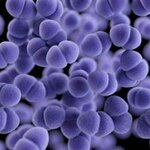Microbiology

A chronic problem in wine making is when yeast that should be busily converting grape sugar into alcohol and carbon dioxide prematurely shuts down, leaving the remaining sugar to instead be consumed by bacteria that can spoil the wine.
The "stuck fermentation"problem has been studied extensively. Biologists have known for years that an ancient biological circuit, based in the membranes of yeast cells, blocks yeast from using other carbon sources when the sugar glucose is present.
This circuit, known as "glucose repression," is especially strong in the yeast species…

Cellular reproduction seems simple but the ability to faithfully copy genetic material and distribute it equally to daughter cells is fundamental to all forms of life - and complex. Even seemingly simple single-celled organisms must have the means to meticulously duplicate their DNA, carefully separate the newly copied genetic material, and delicately divide in two to ensure their offspring survive.
In eukaryotic cells such as those in plants and animals, an elaborate molecular circuitry coordinates duplication and separation of genetic material with division, much as the control knob on a…

Credit: CDC
Listeria is a dreaded bacterium that can be found in foods. The bacterium is notoriously difficult to fight because it has an almost uncanny ability to adapt to changes in its surrounding. In the United States, it is more prevalent in products like raw milk, foods that have not been washed, like organic produce, and improperly handled meat.
Yet in other countries it is broader. Recently in Denmark, 28 people got Listeria from processed food sold in supermarkets. 13 died. More commonly something like canned tuna stored in a refrigerator is safer than unprocessed tuna.
University…

Allergic reactions to food have dramatically increased over the past 10 to 20 years. Dan Peled/AAP, CC BY
By Alexandra Miller, The Conversation and Reema Rattan, The Conversation
Changing the bacteria in the gut could treat and prevent life-threatening allergies, according to research published in the Proceedings of the National Academy of Sciences (PNAS) journal today.
“These findings are a game changer for understanding how allergies develop,” said Dr Simon Keely, senior lecturer in immunology and microbiology at the University of Newcastle. “The number of hospital admissions due to…

Bacteria growing in near darkness can still harvest energy and produce oxygen from sunlight.
Researchers discovered that the cyanobacterial strain Leptolyngbya completely changes its photosynthetic apparatus in order to use far-red light, which has wavelengths longer than 700 nanometers - longer than the range of light that most people can see. Their experiments revealed that these cyanobacteria replace seventeen proteins in three major light-using complexes while also making new chlorophyll pigments that can capture the far-red light, and while using pigments called bilins in new ways.
The…

Even the most careful chosen meal can contain surprises and to defend against infectious microbial fifth columnists in the intestines, a dedicated contingent of immune cells keeps watch within the thin layer of tissue that divides the contents of the gut from the body itself.
New research at Rockefeller University sheds light on the development of a unique class of immune cells known as intraepithelial lymphocytes (IELs) that reside in this critical interface. .
"IELs can originate directly from an organ known as the thymus, or they are induced from other, fully mature lymphocytes…

Emiliania huxleyi, up close and personal. Alison R. Taylor, CC BY
By Assaf Vardi, Weizmann Institute of Science and Ilan Koren, Weizmann Institute of Science
Algae isn’t just found in your garden pond or local river. Sometimes it explodes into vast “blooms” far out to sea, that can be the size of a small country. Such algal blooms can match even a rainforest at taking carbon out of the air. And then, in just a week or two, they are gone – sometimes consumed by viruses.
Given the scale of blooms and their vital role in both marine ecology and climate regulation we must know more about these…

Fungal infections that have been sickening HIV/AIDS patients in Southern California for decades literally grow on trees. For that discovery, we can thank a 13-year-old girl who spent the summer gathering soil and tree samples from areas around Los Angeles hardest hit by infections of the fungus named Cryptococcus gattii (CRIP-to-cock-us GAT-ee-eye).
Cryptococcus, which encompasses a number of species including C. gattii, causes life-threatening infections of the lungs and brain and is responsible for one third of all AIDS-related deaths.
The study found strong genetic evidence that three…

The bacterium Clostridium difficile causes antibiotic-related diarrhea and is a growing problem in the hospital environment and elsewhere in the community. Understanding how the microbe colonizes the human gut when other "healthy" microbes have been destroyed during a course of antibiotics might lead to new ways to control infection.
Writing in Acta Crystallographica Section D Biological Crystallography, Ravi Acharya of the University of Bath and colleagues have reported the first crystal structure of the C. difficile surface protein Cwp84. This cysteine protease enzyme is found on the…

A parasitic fungus - Ophiocordyceps camponoti-rufipedis, known as the "zombie ant fungus" - must kill its ant hosts outside their nest to reproduce and transmit their infection,so they manipulate its victims to die in the vicinity of the colony, ensuring a constant supply of potential new hosts, according to a new paper.
Previous research shows that zombie ant fungi control the behavior of carpenter ant workers -- Camponotus rufipes -- to die with precision attached to leaves in the understory of tropical forests, noted study lead author Raquel Loreto, doctoral candidate in entomology,…